Kingdom of Prussia
The Kingdom of Prussia (German: Königreich Preußen) was a German kingdom that constituted the state of Prussia between 1701 and 1918.[4] It was the driving force behind the unification of Germany in 1871 and was the leading state of the German Empire until its dissolution in 1918.[4] Although it took its name from the region called Prussia, it was based in the Margraviate of Brandenburg, where its capital was Berlin.
Kingdom of Prussia Königreich Preußen | |
|---|---|
| 1701–1918 | |
Anthem:
| |
.svg.png) The Kingdom of Prussia within the German Empire between 1871 and 1918 | |
| Status |
|
| Capital |
|
| Common languages | Official: German Recognised: |
| Religion | Majority: Protestantism (Lutheran and Reformed; since 1817 Prussian United) Minorities:
Roman Catholicism, Judaism |
| Government |
|
| King | |
• 1701–1713 (first) | Frederick I |
• 1888–1918 (last) | Wilhelm II |
| Minister-Presidenta | |
• 1848 (first) | Adolf Heinrich |
• 1918 (last) | Max von Baden |
| Legislature | Landtag |
| Herrenhaus | |
| Abgeordnetenhaus | |
| Historical era | |
• Coronation of Frederick I | 18 January 1701 |
| 14 October 1806 | |
| 9 June 1815 | |
| 5 December 1848 | |
| 18 January 1871 | |
| 28 November 1918 | |
| 28 June 1919 | |
| Area | |
| 1910[1] | 348,779 km2 (134,664 sq mi) |
| Population | |
• 1816[2] | 10,349,031 |
• 1871[2] | 24,689,000 |
• 1910[3] | 40,169,219 |
| Currency |
|
| Today part of | |
| |
 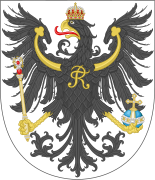 History of Brandenburg and Prussia | ||||
| Northern March 965–983 |
Old Prussians pre-13th century | |||
| Lutician federation 983 – 12th century | ||||
| Margraviate of Brandenburg 1157–1618 (1806) (HRE) (Bohemia 1373–1415) |
Teutonic Order 1224–1525 (Polish fief 1466–1525) | |||
| Duchy of Prussia 1525–1618 (1701) (Polish fief 1525–1657) |
Royal (Polish) Prussia (Poland) 1454/1466 – 1772 | |||
| Brandenburg-Prussia 1618–1701 | ||||
| Kingdom in Prussia 1701–1772 | ||||
| Kingdom of Prussia 1772–1918 | ||||
| Free State of Prussia (Germany) 1918–1947 |
Klaipėda Region (Lithuania) 1920–1939 / 1945–present |
Recovered Territories (Poland) 1918/1945–present | ||
| Brandenburg (Germany) 1947–1952 / 1990–present |
Kaliningrad Oblast (Russia) 1945–present | |||
The kings of Prussia were from the House of Hohenzollern. Prussia was a great power from the time it became a kingdom, through its predecessor, Brandenburg-Prussia, which became a military power under Frederick William, known as "The Great Elector".[5][6][7][8] Prussia continued its rise to power under the guidance of Frederick II, more commonly known as Frederick the Great, who was the third son of Frederick William I.[9] Frederick the Great was instrumental in starting the Seven Years' War, holding his own against Austria, Russia, France and Sweden and establishing Prussia's role in the German states, as well as establishing the country as a European great power.[10] After the might of Prussia was revealed it was considered as a major power among the German states. Throughout the next hundred years Prussia went on to win many battles, and many wars.[11] Because of its power, Prussia continuously tried to unify all the German states (excluding the German cantons in Switzerland) under its rule, and whether Austria would be included in such a unified German domain was an ongoing question.
After the Napoleonic Wars led to the creation of the German Confederation, the issue of unifying the German states caused a number of revolutions throughout the German states, with all states wanting to have their own constitution.[4] Attempts to create a federation remained unsuccessful and the German Confederation collapsed in 1866 when war ensued between its two most powerful member states, Prussia and Austria. The North German Confederation, which lasted from 1867 to 1871, created a closer union between the Prussian-aligned states while Austria and most of Southern Germany remained independent.[4] The North German Confederation was seen as more of an alliance of military strength in the aftermath of the Austro-Prussian War but many of its laws were later used in the German Empire. The German Empire lasted from 1871 to 1918 with the successful unification of all the German states under Prussian hegemony;[4] this was due to the defeat of Napoleon III in the Franco-Prussian War of 1870–71. The war united all the German states against a common enemy, and with the victory came an overwhelming wave of nationalism which changed the opinions of some of those who had been against unification. In 1871, Germany unified into a single country, minus Austria and Switzerland, with Prussia the dominant power.[4]
Prussia is considered the legal predecessor of the unified German Reich (1871–1945) and as such a direct ancestor of today's Federal Republic of Germany.[4] The formal abolition of Prussia, carried out on 25 February 1947 by the fiat of the Allied Control Council, referred to an alleged tradition of the kingdom as a bearer of militarism and reaction, and made way for the current setup of the German states. However, the Free State of Prussia (Freistaat Preußen), which followed the abolition of the Kingdom of Prussia in the aftermath of World War I, was a major democratic force in Weimar Germany until the nationalist coup of 1932 known as the Preußenschlag. The Kingdom left a significant cultural legacy, today notably promoted by the Prussian Cultural Heritage Foundation (Stiftung Preußischer Kulturbesitz (SPK)), which has become one of the largest cultural organisations in the world.[12]
History
Establishment
In 1415 a Hohenzollern Burgrave came from the south to the March of Brandenburg and took control of the area as elector.[4] In 1417 the Hohenzollern was made a prince-elector of the Holy Roman Empire.[4]
After the Polish wars, the newly established Baltic towns of the German states, including Prussia, suffered many economic setbacks.[13] Many of the Prussian towns could not even afford to attend political meetings outside of Prussia. The towns were poverty-stricken, with even the largest town, Danzig, forced to borrow money from elsewhere to pay for trade.[13] Poverty in these towns was partly caused by Prussia's neighbours, who had established and developed such a monopoly on trading that these new towns simply could not compete. These issues led to feuds, wars, trade competition and invasions.[13] However, the fall of these towns gave rise to the nobility, separated the east and the west, and allowed the urban middle class of Brandenburg to prosper.[13]
It was clear in 1440 how different Brandenburg was from the other German territories, as it faced two dangers that the other German territories did not: partition from within and the threat of invasion by its neighbours.[4] It prevented partition by enacting the Dispositio Achillea, which instilled the principle of primogeniture to both the Brandenburg and Franconian territories.[4] The second issue was resolved through expansion. Brandenburg was surrounded on every side by neighbours whose boundaries were merely political.[4] Any neighbour could attack and consume Brandenburg at any moment. The only way to defend herself was to absorb her neighbours before they absorbed her.[4] Through negotiations and marriages Brandenburg slowly but surely expanded her borders, absorbing neighbours and eliminating the threat of attack.
The Hohenzollerns were made rulers of the Margraviate of Brandenburg in 1518. In 1529 the Hohenzollerns secured the reversion of the Duchy of Pomerania after a series of conflicts, and acquired its eastern part following the Peace of Westphalia.
In 1618 the electors of Brandenburg also inherited the Duchy of Prussia, since 1511 ruled by a younger branch of the House of Hohenzollern. In 1525, Albrecht of Brandenburg, the last grand master of the Teutonic Order, secularized his territory and converted it into a duchy. It was ruled in a personal union with Brandenburg, known as "Brandenburg-Prussia". A full union was not possible, since Brandenburg was still legally part of the Holy Roman Empire and the Duchy of Prussia was a fief of Poland. The Teutonic Order had paid homage to Poland since 1466, and the Hohenzollerns continued to pay homage after secularizing Ducal Prussia.
In the course of the Second Northern War, the treaties of Labiau and Wehlau-Bromberg granted the Hohenzollerns full sovereignty over the Prussian duchy by September 1657.
In return for an alliance against France in the War of the Spanish Succession, the Great Elector's son, Frederick III, was allowed to elevate Prussia to a kingdom in the Crown Treaty of 16 November 1700. Frederick crowned himself "King in Prussia" as Frederick I on 18 January 1701. Legally, no kingdoms could exist in the Holy Roman Empire except for Bohemia. However, Frederick took the line that since Prussia had never been part of the empire and the Hohenzollerns were fully sovereign over it, he could elevate Prussia to a kingdom.
The style "King in Prussia" was adopted to acknowledge the legal fiction that the Hohenzollerns were legally kings only in their former duchy. In Brandenburg and the portions of their domains that were within the Empire, they were still legally only electors under the overlordship of the emperor. However, by this time the emperor's authority was only nominal. The rulers of the empire's various territories acted largely as the rulers of sovereign states, and only acknowledged the emperor's suzerainty in a formal way. In addition, the Duchy was only the eastern half of the region of Prussia; the western half was held by the King of Poland. While the personal union between Brandenburg and Prussia legally continued until the end of the empire in 1806, from 1701 onward Brandenburg was de facto treated as an integral part of the kingdom. Since the Hohenzollerns were nominally still subjects of the emperor within the parts of their domains that were part of the empire, they continued to use the additional title of Elector of Brandenburg until the empire was dissolved. It was not until 1772 that the title was changed to "King of Prussia".
1700–1721: Aftermath of the Thirty-Years' War and the Great Northern War
The Kingdom of Prussia was devastated from the Thirty Years' War and poor in natural resources. Its territory was disjointed, stretching 1,200 km (750 mi) from the lands of the Duchy of Prussia on the south-east coast of the Baltic Sea to the Hohenzollern heartland of Brandenburg, with the exclaves of Cleves, Mark and Ravensberg in the Rhineland. In 1708 about one third of the population of the Duchy of Prussia died of bubonic plague.[14] The plague reached Prenzlau in August 1710 but receded before it could reach the capital Berlin, which was only 80 km (50 mi) away.
The Great Northern War was the first major conflict that the Kingdom of Prussia was involved in. Starting in 1700, the Great Northern War involved a coalition led by Tsarist Russia against the dominant North European power at the time, the Swedish Empire. Frederick William in 1705 tried to get Prussia involved in the war, stating it "best Prussia has her own army and make her own decisions."[15] His views, however, were not considered acceptable by those in power. It was not until 1713 that Frederick William gained full royal powers.[15] Therefore, in 1715, Prussia, led by Frederick William, joined the coalition for various reasons,[15] including the danger of being attacked from both her rear and the sea; her claims on Pomerania; and the fact that if she stood aside and Sweden lost she would not get a share of the territory.[4][15] Prussia only participated in one battle, the Battle of Stresow on the island of Rügen, as the war had already been practically decided in the 1709 Battle of Poltava. In the Treaty of Stockholm Prussia gained all of Swedish Pomerania east of the river Oder. Sweden would however keep Vorpommern until 1815. The Great Northern War not only marked the end of the Swedish Empire but also elevated Prussia and Russia as new powers in Europe.[16]
The Great Elector incorporated the Junkers, the landed aristocracy, into the empire's bureaucracy and military machine, giving them a vested interest in the Prussian Army and compulsory education.[17] King Frederick William I inaugurated the Prussian compulsory system in 1717.[17]
1740–1762: Silesian Wars
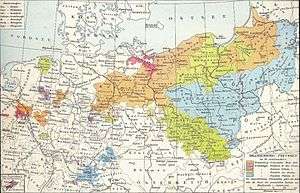
In 1740 King Frederick II (Frederick the Great) came to the throne. Using the pretext of a 1537 treaty (vetoed by Emperor Ferdinand I) by which parts of Silesia were to pass to Brandenburg after the extinction of its ruling Piast dynasty, Frederick invaded Silesia, thereby beginning the War of the Austrian Succession. After rapidly occupying Silesia, Frederick offered to protect Archduchess Maria Theresa of Austria if the province were turned over to him. The offer was rejected, but Austria faced several other opponents, and Frederick was eventually able to gain formal cession with the Treaty of Berlin in 1742.
To the surprise of many, Austria managed to renew the war successfully. In 1744 Frederick invaded again to forestall reprisals and to claim, this time, the province of Bohemia. He failed, but French pressure on Austria's ally Great Britain led to a series of treaties and compromises, culminating in the 1748 Treaty of Aix-la-Chapelle that restored peace and left Prussia in possession of most of Silesia.
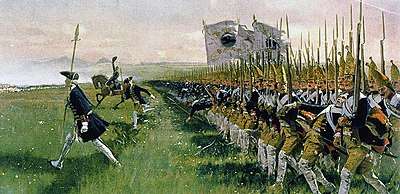
Humiliated by the cession of Silesia, Austria worked to secure an alliance with France and Russia (the "Diplomatic Revolution"), while Prussia drifted into Great Britain's camp forming the Anglo-Prussian Alliance. When Frederick preemptively invaded Saxony and Bohemia over the course of a few months in 1756–1757, he began a Third Silesian War and initiated the Seven Years' War.
This war was a desperate struggle for the Prussian Army, and the fact that it managed to fight much of Europe to a draw bears witness to Frederick's military skills. Facing Austria, Russia, France, and Sweden simultaneously, and with only Hanover (and the non-continental British) as notable allies, Frederick managed to prevent serious invasion until October 1760, when the Russian army briefly occupied Berlin and Königsberg. The situation became progressively grimmer, however, until the death in 1762 of Empress Elizabeth of Russia (Miracle of the House of Brandenburg). The accession of the Prussophile Peter III relieved the pressure on the eastern front. Sweden also exited the war at about the same time.
Defeating the Austrian army at the Battle of Burkersdorf and relying on continuing British success against France in the war's colonial theatres, Prussia was finally able to force a status quo ante bellum on the continent. This result confirmed Prussia's major role within the German states and established the country as a European great power. Frederick, appalled by the near-defeat of Prussia, lived out his days as a much more peaceable ruler.
1772, 1793, and 1795: Partitions of Polish–Lithuanian Commonwealth
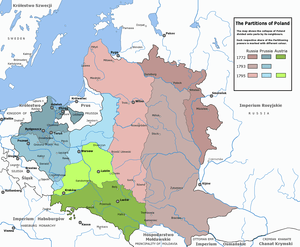
To the east and south of Prussia, the Polish–Lithuanian Commonwealth had gradually weakened during the 18th century. Alarmed by increasing Russian influences in Polish affairs and by a possible expansion of the Russian Empire, Frederick was instrumental in initiating the first of the Partitions of Poland between Russia, Prussia, and Austria in 1772 to maintain a balance of power. The Kingdom of Prussia annexed most of the Polish province of Royal Prussia, including Warmia; the annexed land was organised the following year into the Province of West Prussia. The new territory connected the Province of East Prussia (the territory previously known as the Duchy of Prussia) with the Province of Pomerania, uniting the kingdom's eastern territories.
After Frederick died in 1786, his nephew Fredrick William II continued the partitions, gaining a large part of western Poland in 1793.
In 1795 the Kingdom of Poland ceased to exist and a large area (including Warsaw) to the south of East Prussia became part of Prussia. These new territories were organised into the Provinces of New Silesia, South Prussia, and New East Prussia.
In 1787 Prussia invaded Holland to restore the Orangist stadtholderate against the increasingly rebellious Patriots, who sought to overthrow House of Orange-Nassau and establish a democratic republic. The direct cause of the invasion was the Arrest at Goejanverwellesluis, where Frederick William II's sister Wilhelmina of Prussia, also stadtholder William V of Orange's wife, was stopped by a band of Patriots who denied her passage to The Hague to reclaim her husband's position.
1801–1815: Napoleonic Wars
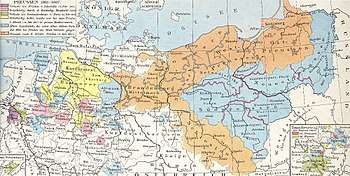
The Treaty of Basel (1795) ended the War of the First Coalition against France. In it, the First French Republic and Prussia had stipulated that the latter would ensure the Holy Roman Empire's neutrality in all the latter's territories north of the demarcation line of the river Main, including the British continental dominions of the Electorate of Hanover and the Duchies of Bremen-Verden. To this end, Hanover (including Bremen-Verden) also had to provide troops for the so-called demarcation army maintaining this state of armed neutrality.
In the course of the War of the Second Coalition against France (1799–1802) Napoleon Bonaparte urged Prussia to occupy the continental British dominions. In 1801 24,000 Prussian soldiers invaded, surprising Hanover, which surrendered without a fight. In April 1801 the Prussian troops arrived in Bremen-Verden's capital Stade and stayed there until October of the same year. The United Kingdom of Great Britain and Ireland first ignored Prussia's hostility, but when it joined the pro-French coalition of armed "neutral" powers such as Denmark–Norway and Russia, Britain started to capture Prussian sea vessels. After the battle of Copenhagen the coalition fell apart and Prussia again withdrew its troops.
At Napoleon's instigation, Prussia recaptured British Hanover and Bremen-Verden in early 1806. On August 6 of the same year, the Holy Roman Empire was dissolved as a result of Napoleon's victories over Austria. The title of Kurfürst (Prince-elector) of Brandenburg became meaningless, and was dropped. Nonetheless, Frederick William III was now de jure as well as de facto sovereign of all of the Hohenzollern domains.[18] Before this time, the Hohenzollern sovereign had held many titles and crowns, from Supreme Governor of the Protestant Churches (summus episcopus) to King, Elector, Grand Duke, Duke for the various regions and realms under his rule. After 1806 he was simply King of Prussia and summus episcopus.
.jpg)
But when Prussia, after it turned against the French Empire, was defeated in the Battle of Jena–Auerstedt (October 14, 1806), Frederick William III was forced to temporarily flee to remote Memel.[19] After the Treaties of Tilsit in 1807, Prussia lost about half of its territory, including the land gained from the Second and Third Partitions of Poland (which now fell to the Duchy of Warsaw) and all land west of the Elbe River. France recaptured Prussian-occupied Hanover, including Bremen-Verden. The remainder of the kingdom was occupied by French troops (at Prussia's expense) and the king was obliged to make an alliance with France and join the Continental System.
The Prussian reforms were a reaction to the Prussian defeat in 1806 and the Treaties of Tilsit. It describes a series of constitutional, administrative, social and economic reforms of the kingdom of Prussia. They are sometimes known as the Stein-Hardenberg Reforms after Karl Freiherr vom Stein and Karl August Fürst von Hardenberg, their main instigators.
After the defeat of Napoleon in Russia in 1812, Prussia quit the alliance and took part in the Sixth Coalition during the "Wars of Liberation" (Befreiungskriege) against the French occupation. Prussian troops under Marshal Gebhard Leberecht von Blücher contributed crucially in the Battle of Waterloo of 1815 to the final victory over Napoleon.
1815: After Napoleon
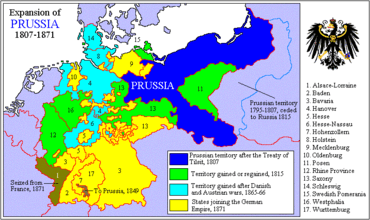
Prussia's reward for its part in France's defeat came at the Congress of Vienna. It regained most of its pre-1806 territory. Notable exceptions included much of the territory annexed in the Second and Third Partitions of Poland, which became Congress Poland under Russian rule (though it did retain Danzig, acquired in the Second Partition). It also did not regain several of its former towns in the south. However, as compensation it picked up some new territory, including 40% of the Kingdom of Saxony and much of Westphalia and the Rhineland. Prussia now stretched uninterrupted from the Niemen in the east to the Elbe in the west, and possessed a chain of disconnected territories west of the Elbe. This left Prussia as the only great power with a predominantly German-speaking population.
With these gains in territory, the kingdom was reorganised into 10 provinces. Most of the kingdom, aside from the Provinces of East Prussia, West Prussia, and Posen, became part of the new German Confederation, a confederacy of 39 sovereign states (including Austria and Bohemia) replacing the defunct Holy Roman Empire.
Frederick William III submitted Prussia to a number of administrative reforms, among others reorganising the government by way of ministries, which remained formative for the following hundred years.
As to religion, reformed Calvinist Frederick William III—as Supreme Governor of the Protestant Churches—asserted his long-cherished project (started in 1798) to unite the Lutheran and the Reformed Church in 1817, (see Prussian Union). The Calvinist minority, strongly supported by its co-religionist Frederick William III, and the partially reluctant Lutheran majority formed the united Protestant Evangelical Church in Prussia. However, ensuing quarrels causing a permanent schism among the Lutherans into united and Old Lutherans by 1830.
As a consequence of the Revolutions of 1848, the Principalities of Hohenzollern-Sigmaringen and Hohenzollern-Hechingen (ruled by a Catholic cadet branch of the House of Hohenzollern) were annexed by Prussia in 1850, later united as Province of Hohenzollern.
1848–1871: German wars of unification
During the half-century that followed the Congress of Vienna a conflict of ideals took place within the German Confederation between the formation of a single German nation and the conservation of the current collection of smaller German states and kingdoms. The main debate centered around whether Prussia or the Austrian Empire should be the leading member of any unified Germany. Those advocating for Prussian leadership contended that Austria had far too many non-German interests to work for the greater good of Germany. They argued that Prussia, as by far the most powerful state with a majority of German-speakers, was best suited to lead the new nation.
The establishment of the German Customs Union (Zollverein) in 1834, which excluded Austria, increased Prussian influence over the member states. In the wake of the Revolutions of 1848, the Frankfurt Parliament in 1849 offered King Frederick William IV of Prussia the crown of a united Germany. Frederick William refused the offer on the grounds that revolutionary assemblies could not grant royal titles. But he also refused for two other reasons: to do so would have done little to end the internal power-struggle between Austria and Prussia, and all Prussian kings (up to and including William I) feared that the formation of a German Empire would mean the end of Prussia's independence within the German states.
In 1848 actions taken by Denmark towards the Duchies of Schleswig and Holstein led to the First War of Schleswig (1848–51) between Denmark and the German Confederation, resulting in a Danish victory.
Frederick William issued Prussia's first constitution by his own authority in 1848. This document—moderate by the standards of the time but conservative by today's standards—provided for a two-chamber parliament, the Landtag. The lower house, later known as the Abgeordnetenhaus, was elected by all taxpayers, who were divided into three classes whose votes were weighted according to the amount of taxes paid. Women and those who paid no taxes had no vote. This allowed just over one-third of the voters to choose 85% of the legislature, all but assuring dominance by the more well-to-do men of the population. The upper house, later renamed the Herrenhaus ("House of Lords"), was appointed by the king. He retained full executive authority and ministers were responsible only to him. As a result, the grip of the landowning classes, the Junkers, remained unbroken, especially in the eastern provinces.
Frederick William suffered a stroke in 1857, and his younger brother, Prince William, became regent. William pursued a considerably more moderate policy. Upon Frederick William IV's death in 1861 he succeeded to the Prussian throne as William I. However, shortly after becoming king, he faced a dispute with his parliament over the size of the army. The parliament, dominated by the liberals, balked at William's desire to increase the number of regiments and withheld approval of the budget to pay for its cost. A deadlock ensued, and William seriously considered abdicating in favour of his son, Crown Prince Frederick William. Ultimately, he decided to appoint as prime minister Otto von Bismarck, at that time the Prussian ambassador to France. Bismarck took office on September 23, 1862.
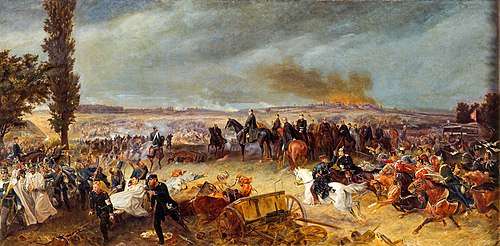
Although Bismarck had a reputation as an unyielding conservative, he initially inclined to seek a compromise over the budget issue. However, William refused to consider it; he viewed defence issues as the crown's personal province. Forced into a policy of confrontation, Bismarck came up with a novel theory. Under the constitution, the king and the parliament were responsible for agreeing on the budget. Bismarck argued that since they had failed to come to an agreement, there was a "hole" in the constitution, and the government had to continue to collect taxes and disburse funds in accordance with the old budget in order to keep functioning. The government thus operated without a new budget from 1862 to 1866, allowing Bismarck to implement William's military reforms.
The liberals violently denounced Bismarck for what they saw as his disregard for the fundamental law of the kingdom. However, Bismarck's real plan was an accommodation with liberalism. Although he had opposed German unification earlier in his career, he had now come to believe it inevitable. To his mind, the conservative forces had to take the lead in the drive toward creating a unified nation in order to keep from being eclipsed. He also believed that the middle-class liberals wanted a unified Germany more than they wanted to break the grip of the traditional forces over society. He thus embarked on a drive to form a united Germany under Prussian leadership, and guided Prussia through three wars which ultimately achieved this goal.
The first of these wars was the Second War of Schleswig (1864), which Prussia initiated and succeeded in, and in which it gained the assistance of Austria. Denmark was soundly defeated and surrendered both Schleswig and Holstein, to Prussia and Austria respectively.
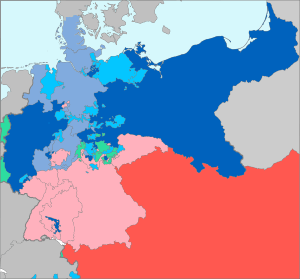
The divided administration of Schleswig and Holstein then became the trigger for the Austro-Prussian War of 1866—also known as the Seven Weeks' War. Prussia, allied with the Kingdom of Italy and various northern German states, declared war on the Austrian Empire. The Austrian-led coalition was crushed, and Prussia annexed four of its smaller allies—the Kingdom of Hanover, the Electorate of Hesse, the Duchy of Nassau and the Free City of Frankfurt. Prussia also annexed Schleswig and Holstein, and also effectively annexed Saxe-Lauenburg by forcing it into a personal union with Prussia (which was turned into a full union in 1876). King William initially wanted to take territory from Austria itself, but Bismarck persuaded him to abandon the idea. While Bismarck wanted Austria to play no future role in German affairs, he foresaw that Austria could be a valuable future ally.
With these gains in territory, the Prussian possessions in the Rhineland and Westphalia became geographically connected to the rest of the kingdom for the first time. Counting the de facto annexation of Saxe-Lauenburg, Prussia now stretched uninterrupted across the northern two-thirds of Germany. It would remain at this size until the overthrow of the monarchy in 1918.
Bismarck used this opportunity to end the budget dispute with parliament. He proposed a bill of indemnity granting him retroactive approval for governing without a legal budget. He guessed, correctly as it turned out, that this would lead to a split between his liberal adversaries. While some of them argued that there could be no compromise with the principle of constitutional government, most of the liberals decided to support the bill in hopes of winning more freedom in the future.
The German Confederation was dissolved as part of the war. In its place, Prussia cajoled the 21 states north of the Main into forming the North German Confederation in 1867. Prussia was the dominant state in this new grouping, with four-fifths of its territory and population—more than the other members of the confederation combined. Its near-total control was cemented in a constitution written by Bismarck. Executive power was vested in a president—a hereditary office of the rulers of Prussia. He was assisted by a chancellor responsible only to the president. There was also a bicameral parliament. The lower house, or Reichstag (Diet), was elected by universal male suffrage. The upper house, or Bundesrat (Federal Council) was appointed by the state governments. The Bundesrat was, in practice, the stronger chamber. Prussia had 17 of 43 votes and could easily control proceedings through alliances with the other states. For all intents and purposes, Bismarck dominated the new grouping. He served as his own foreign minister for virtually his entire tenure as prime minister of Prussia, and in that capacity was able to instruct the Prussian delegates to the Bundesrat.
The southern German states (except Austria) were forced to accept military alliances with Prussia, and Prussia began steps to merge them with the North German Confederation. Bismarck's planned Kleindeutschland unification of Germany had come considerably closer to realisation.
The final act came with the Franco-Prussian War (1870–1871), where Bismarck maneuvered Emperor Napoleon III of France into declaring war on Prussia. Activating the German alliances put in place after the Austro-Prussian War, the German states came together and swiftly defeated France, even managing to take Napoleon prisoner (2 September 1870). Even before then, Bismarck was able to complete the work of unifying Germany under Prussian leadership. The patriotic fervour aroused by the war against France overwhelmed the remaining opponents of a unified Kleindeutschland nation, and on 18 January 1871 (the 170th anniversary of the coronation of the first Prussian king, Frederick I), the German Empire was proclaimed in the Hall of Mirrors at Versailles[22] outside of Paris, while the French capital was still under siege. King William became the first emperor (Kaiser) of a unified Germany.
1871–1918: Peak and fall
Bismarck's new empire was the most powerful state on the Continent. Prussia's dominance over the new empire was almost as absolute as it was with the North German Confederation. It included two-thirds of the empire's territory and three-fifths of its population. The imperial crown was a hereditary office of the House of Hohenzollern. Prussia also had a large plurality of seats in the Bundesrat, with 17 votes out of 58 (17 out of 61 after 1911); no other state had more than six votes. As before, it could effectively control the proceedings with the support of its allies in the secondary states. As mentioned above, Bismarck served as foreign minister of Prussia for almost his entire career, and in that role instructed the Prussian deputies to the Bundesrat. The Imperial Army was essentially an enlarged Prussian army, and the embassies of the new empire were mostly old Prussian embassies. The constitution of the German Empire was essentially an amended version of the constitution of the North German Confederation.

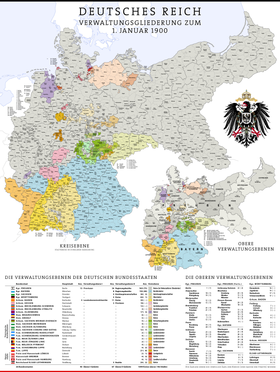
However, the seeds for future problems lay in a gross disparity between the imperial and Prussian systems. The empire granted the vote to all men over 25. However, Prussia retained its restrictive three-class voting system, in which the well-to-do had 17½ times the voting power of the rest of the population. Since the imperial chancellor was, except for two periods (January–November 1873 and 1892–94) also prime minister of Prussia, this meant that for most of the empire's existence, the king/emperor and prime minister/chancellor had to seek majorities from legislatures elected by two completely different franchises.
At the time of the empire's creation, both Prussia and Germany were roughly two-thirds rural. Within 20 years, the situation was reversed; the cities and towns accounted for two-thirds of the population. However, in both the kingdom and the empire, the constituencies were never redrawn to reflect the growing population and influence of the cities and towns. This meant that rural areas were grossly overrepresented from the 1890s onward.
Bismarck realised that the rest of Europe was skeptical of his powerful new Reich, and turned his attention to preserving peace with such acts as the Congress of Berlin. The new German Empire improved its already-strong relations with Britain. The ties between London and Berlin had already been sealed with a golden braid in 1858, when Crown Prince Frederick William of Prussia married Princess Victoria of Britain.
William I died in 1888, and the Crown Prince succeeded to the throne as Frederick III. The new emperor, a decided Anglophile, planned to transform Prussia and the empire into a more liberal and democratic monarchy based on the British model. However, Frederick was already ill with inoperable throat cancer, and died after only 99 days on the throne. He was succeeded by his 29-year-old son, William II. As a boy, William had rebelled against his parents' efforts to mould him as a liberal, and had become thoroughly Prussianized under Bismarck's tutelage.
The new Kaiser Wiliam rapidly soured relations with the British and Russian royal families (despite being closely related to them), becoming their rival and ultimately their enemy. Before and during World War I (1914–1918), Prussia supplied significant numbers of soldiers and sailors in the German military, and Prussian Junkers dominated the higher ranks. In addition, portions of the Eastern Front were fought on Prussian soil. Prussia – along with Germany as a whole – experienced increasing troubles with revolutionaries during the war. The Great War ended by armistice on 11 November 1918.
Uprisings in Berlin and other centres began the civil conflict of the German Revolution of 1918–19 (German: Novemberrevolution). By late 1918, the Prussian House of Representatives was controlled by the Social Democratic Party of Germany (SPD), which advocated Marxism. William knew that he had lost his imperial crown for good, but still hoped to retain his Prussian crown; he believed that as ruler of two-thirds of Germany, he could remain a major figure in any successor regime. However, William discovered this was impossible under the imperial constitution. Although he believed he ruled the empire in personal union with Prussia, the imperial constitution stipulated that the imperial crown was tied to the Prussian crown. In any event, he had lost support of the military who might have fought for him. William's abdication as both king of Prussia and German emperor was announced on 9 November 1918, and he went into exile in the Netherlands the next day. With armed revolts, mass strikes, and street fighting in Berlin, the Prussian state government declared a state of siege and appealed for imperial military aid. The Garde-Kavallerie-Schützen-Division, commanded by Waldemar Pabst, moved against the strikers in Berlin. By the end of the fighting on 16 March, they had killed approximately 1,200 people, many of them unarmed and uninvolved. The revolutionary period lasted from November 1918 until the establishment in August 1919 of a republic that later became known as the Weimar Republic.
Prussia was incorporated as a state in the Weimar Republic. Under the republic, undemocratic public institutions were abolished, including the disappearance "of the Prussian Upper House, [and] the former Prussian Lower House that had been elected in accordance with the three-class suffrage".[23]
State
Government
The joint authority, feudal and bureaucratic, on which Prussian absolute monarchy was based, saw its interests laid in suppression of the drive for personal freedom and democratic rights. It therefore had to recourse on police methods.[24] The "police state", as Otto Hintze described it, replaced the older system with its feudal squirearchy run in the interests of the ruling class, but which in its rudimentary form was a constitutional state.[25]
Politics

The Kingdom of Prussia was an absolute monarchy until the Revolutions of 1848 in the German states, after which Prussia became a constitutional monarchy and Adolf Heinrich von Arnim-Boitzenburg was appointed as Prussia's first prime minister. Following Prussia's first constitution, a two-house parliament was formed. The lower house, or Landtag was elected by all taxpayers, who were divided into three classes according to the amount of taxes paid. This allowed just over 25% of the voters to choose 85% of the legislature, all but assuring dominance by the more well-to-do elements of the population. The upper house, which was later renamed the Prussian House of Lords, was appointed by the king. He retained full executive authority and ministers were responsible only to him. As a result, the grip of the landowning classes, the Prussian Junkers, remained unbroken, especially in the eastern provinces. Prussian Secret Police, formed in response to the Revolutions of 1848 in the German states, aided the conservative government.
Constitutions
There were two constitutions during the kingdom's existence, the 1848 and 1850. The constitution of 1848 was enacted and set into effect on 5 December 1848, by Frederick William IV. This was set out in response to the revolutions of 1848. The second constitution was enacted on 31 January 1850 and was continually amended in the following years.
The Constitution of 1848 occurred under the rule of Frederick William IV who took power from his father after his death in the year 1840. After taking power, William set an appointment of committees to confer on points of various questions. With this the king believed that he could give a sense of unity without revolution. The government was then cautiously brought together, all members of the eight provincial assemblies, and split into two houses, a house of lords and a second house that enveloped the three estates of the knights, the burgesses and the peasants. Although they had no real power and the king did not consult them or allow them to veto or argue the legislatures that were being made, it was a step towards a constitutional state. Known as the "March Days", radical changes began to occur. When the king refused to add the United Diets into an actual representative institution, the people began to rebel. On 18 March the king made the decision to agree to some concessions. However, there were multiple stand-offs with soldiers as he had not been able to stop them from attacking even peaceful crowds. In March the king agreed to demands issued by the people and made a number of concessions. At the 22 May 1848, convention he put out the sketch of the new constitution. The people submitted a revised draft on 26 July 1848. When all discussions were finished, Frederick dissolved the convention and the constitution was officially put in place on 5 December 1848.[26][27]
The constitution was separated into 105 different articles headed under eight separate headings. The nine headings are titled The Territory of the State, The Rights of the Prussians, The King, The Ministers, The Chambers, The Judicial Power, Public Officials Not Belonging to the Judicial Class, The Finances and The Communes, Circuits, Districts, and Provincial Bodies. Each of these groups varies in numbers of articles with the seventh and ninth sections having only one article each and the second section having forty separate articles. There have also been fourteen provisions divided into General Provisions and Temporary Provisions.[26]
Religion
The Prussian constitution of 1850 allowed for the freedom of conscience, the freedom of public and private worship and the freedom of association onto religious bodies. It stated that all churches and other religious associations should administer everything independently and privately from the state and that no part of the government may affect the Church. The constitution also stated that all children should be taught their religion from people of their own religion and not by someone else.[26][28]
As a breakdown of the religion of the kingdom, according to a census taken in the early or mid 1800s, around the 1830s there was a division of six religions based on one million people. According to this census there were 609,427.0 practising Protestants, 376,177.1 practising Roman Catholics, 13,348.8 practising Jews, 925.1 Mennonites, 121.4 Greek Orthodox and 0.6 Muslims. At this time the total population was 14,098,125 people, meaning there were approximately 8,591,778 practising Protestants, 5,303,392 practising Roman Catholics,188,193 practising Jews, 13,042 Mennonites, 1,712 Greek Orthodox, and 8 Muslims.[29]
Although dominated by Protestant Lutherans (along with some Reformed), it contained millions of Catholics in the west and in Poland. There were numerous Catholic populations in the Rhineland and parts of Westphalia. In addition, West Prussia, Warmia, Silesia, and the Province of Posen had predominantly Catholic Polish-speaking populations. East Prussia's southern region of Masuria was mostly made up of Germanised Protestant Masurs.
Subdivisions
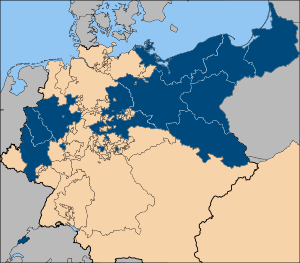

The original core regions of the Kingdom of Prussia were the Margraviate of Brandenburg and the Duchy of Prussia which together formed Brandenburg-Prussia. A Further Pomeranian province had been held by Prussia since 1653. Combined with Swedish Pomerania, gained from Sweden in 1720 and 1815, this region formed the Province of Pomerania. Prussian gains in the Silesian Wars led to the formation of the Province of Silesia in 1740.
After the First Partition of Poland in 1772, the newly annexed Royal Prussia and Warmia became the Province of West Prussia, while the Duchy of Prussia (along with part of Warmia) became the Province of East Prussia. Other annexations along the Noteć (Netze) River became the Netze District. Following the second and third partitions (1793–1795), the new Prussian annexations became the Provinces of New Silesia, South Prussia, and New East Prussia, with the Netze District redivided between West and South Prussia. These three provinces were ultimately lost to Congress Poland after the Congress of Vienna in 1815, except for the western part of South Prussia, which would form part of the Grand Duchy of Posen.
Following the major western gains made by Prussia after the Vienna Congress, a total of ten provinces were established, each one subdivided further into smaller administrative regions known as Regierungsbezirke. The provinces were:
- Province of Brandenburg
- Province of East Prussia
- Province of Jülich-Cleves-Berg
- Grand Duchy of the Lower Rhine
- Province of Pomerania
- Grand Duchy of Posen (autonomous, outside of German Confederation)
- Province of Saxony
- Province of Silesia
- Province of West Prussia
- Province of Westphalia
In 1822 the provinces of Jülich-Cleves-Berg and the Lower Rhine were merged to form the Rhine Province. In 1829, the Provinces of East and West Prussia merged to form the Province of Prussia, but the separate provinces were reformed in 1878. The principalities of Hohenzollern-Sigmaringen and Hohenzollern-Hechingen were annexed in 1850 to form the Province of Hohenzollern.
After Prussia's victory in the 1866 Austro-Prussian War, territories annexed by Prussia were reorganised into three new provinces:
- Hanover
- Hesse-Nassau
- Schleswig-Holstein
References
- "German Empire: administrative subdivision and municipalities, 1900 to 1910" (in German). Retrieved 2007-05-02.
- "Königreich Preußen (1701–1918)" (in German). Retrieved 2007-05-02.
- "German Empire: administrative subdivision and municipalities, 1900 to 1910" (in German). Retrieved 2007-05-02.
- Marriott, J. A. R., and Charles Grant Robertson. The Evolution of Prussia, the Making of an Empire. Rev. ed. Oxford: Clarendon Press, 1946.
- Fueter, Eduard (1922). World history, 1815–1920. United States of America: Harcourt, Brace and Company. pp. 25–28, 36–44. ISBN 1-58477-077-5.
- Danilovic, Vesna. "When the Stakes Are High—Deterrence and Conflict among Major Powers", University of Michigan Press (2002), p 27, p225–228
- Aping the Great Powers: Frederick the Great and the Defence of Prussia's International Position 1763–86, Pp. 286–307.
- The Rise of Prussia Archived June 10, 2010, at the Wayback Machine
- Horn, D. B. "The Youth of Frederick the Great 1712–30." In Frederick the Great and the Rise of Prussia, 9–10. 3rd ed. London: English Universities Press, 1964.
- Horn, D. B. "The Seven Years' War." In Frederick the Great and the Rise of Prussia, pp. 81–101. 3rd ed. London: English Universities Press, 1964.
- Atkinson, C. T. A History of Germany, 1715–1815. New York: Barnes & Noble, 1969.
- Langels, Otto: "Constitutional Reality: 50 years of the Prussian Cultural Heritage Foundation", in German, Deutschlandradio, 25 July 2007
- Carsten, F. L. The Origins of Prussia. Oxford: Clarendon Press, 1954.
- Walker, Mack, The Salzburg transaction: expulsion and redemption in eighteenth-century Germany, (Cornell University Press, 1992), 74.
- Feuchtwanger, E. J. Prussia: Myth and Reality: The Role of Prussia in German History. Chicago: Henry Regnery Company, 1970.
- Shennan, Margaret. The Rise of Brandenburg-Prussia. London: Routledge, 1995
- Rothbard, Murray N. (1999). Education: Free & Compulsory. Auburn, Alabama: The Ludwig von Mises Institute. pp. 24–27. ISBN 0-945466-22-6.
- When the Holy Roman Empire was dissolved in 1806, the function of prince-electors electing its emperors had lapsed.
- "History of Klaipėda (Memel) | True Lithuania". www.truelithuania.com. Retrieved 4 November 2017.
- Prussia allies in the Austro-Prussian War were: Anhalt, Bremen, Brunswick, Lauenburg, Lippe-Detmold, Lübeck, Hamburg, Mecklenburg-Schwerin, Grand Duchy of Mecklenburg-Strelitz, Oldenburg, Saxe-Altenburg, Saxe-Coburg and Gotha, Schwarzburg-Sondershausen, Waldeck-Pyrmont.
- Austrian allies in the Austro-Prussian War were: Baden, Bavaria, Hanover, Hesse-Darmstadt, Hesse-Kassel (or Hesse-Cassel), Nassau, Reuss-Greiz, Saxe-Meiningen, Saxony, Schaumburg-Lippe, Württemberg.
- Die Reichsgründung 1871 (The Foundation of the Empire, 1871), Lebendiges virtuelles Museum Online, accessed 2008-12-22. German text translated: [...] on the wishes of Wilhelm I, on the 170th anniversary of the elevation of the House of Brandenburg to princely status on 18 January 1701, the assembled German princes and high military officials proclaimed Wilhelm I as German Emperor in the Hall of Mirrors at the Versailles Palace.
- Rosenberg, Arthur (1936), A History of the German Republic, translated from the German by Ian Morrow and Marie Sieveking, London: Methuen & Co Ltd
- Jacoby 1973, p. 34.
- Hintze, Der Commissarius
- Wilhelm, Friedrich; Robinson, James (1894). "Supplement: Constitution of the Kingdom of Prussia". Annals of the American Academy of Political and Social Science. Sage Publications Inc., American Academy of Political and Social Science. 5 (Supplement 8): 1–54. JSTOR 1009032.
- Chastain, James. Prussia (1998)(revised 2004) found at http://www.ohio.edu/chastain/ip/prussia.htm
- Burgess, John (1887). "The Culturconflict" in Prussia". Political Science Quarterly. The Academy of Political Science. 2 (2): 313–340. JSTOR 2139282.
- Hebeler, Bernard (1847). "Statistics of Prussia". Journal of the Statistical Society of London. Wiley for the Royal Statistical Society. 10 (2): 154–186. JSTOR 2337688.
Bibliography
- Hintze, Otto. Der Commissarius und seine Bedeutung in der allgemeinen Verwaltungsgeschichte. Retrieved 2015-06-15.CS1 maint: ref=harv (link)
- Jacoby, Henry (1973-01-01). The Bureaucratization of the World. University of California Press. ISBN 978-0-520-02083-2. Retrieved 2015-06-15.CS1 maint: ref=harv (link)
.svg.png)
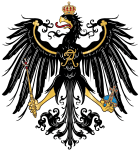

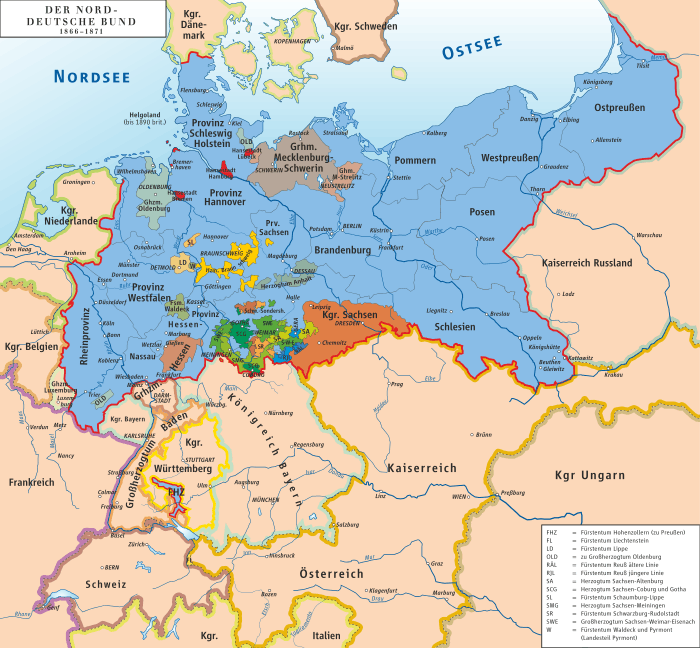
-en.png)